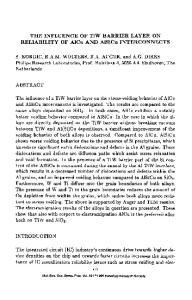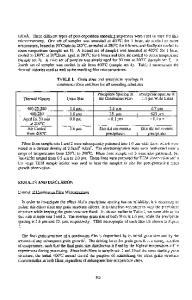The Influence of Grain Structure on the Reliability of Narrow Al-Based Interconnects
- PDF / 1,969,290 Bytes
- 6 Pages / 414.72 x 648 pts Page_size
- 91 Downloads / 474 Views
OF NARROW AL-BASED INTERCONNECTS S.H.Kang, C.Kim, F.Y.Gdnin* and J.W.Morris,Jr. Center for Advanced Materials, Lawrence Berkeley Laboratory and the Department of Materials Science and Engineering, University of California, Berkeley, CA 94720 *Chemistry and Materials Science, Lawrence Livermore National Laboratory, Livermore, CA 94550
ABSTRACT The work reported here concerns the effect of grain structure on electromigration failure in pure Al and Al-2wt.%Cu-lwt.%Si lines. The grain structures of fine lines were controlled by annealing after patterning to promote the formation of "bamboo" structures. Significant improvements in the median time to failure (MTF) and the deviation of the time to failure (DTF) were observed with the development of near-bamboo structures with polygranular-segment lengths shorter than - 5 ltm. The most common failure sites are voids or slits across bamboo grains at the upstream ends of polygranular segments. The time-to-failure decreases with the polygranular segment length, and can be significantly enhanced by controlling the grain structure.
INTRODUCTION Electromigration failure occurs by the accumulation of vacancies at sites where microstructural irregularities create a divergence in the current-enhanced vacancy flux [ 1]. Recent studies have shown that the predominant failure sites in narrow interconnects with partially "bamboo" grain structure are located at the longest polygranular segments in the line [2]. It has been also reported that the electromigration lifetime increases significantly as the number of grain-boundary triple junctions per unit line length decreases [3]. These reports suggest that the control of grain structure, to reduce the lengths of polygranular segments and the number of grains in each polygranular segment, will enhance the reliability of the interconnects. The work reported here studies the influence of grain structure on electromigration failure in pure Al and Al-2wt.%Cu-lwt.%Si lines with 1 ýtm and 1.3 ýtm widths, respectively. It is well documented that both the median time to failure (MTF) and the deviation of the time to failure (DTF) change with the width of lines patterned from a given grain structure [4-7]. The present work focuses on the influence of grain structure at given width. The structure is modified by annealing pre-patterned lines at moderate temperature to create microstructures that contain a high fraction of bamboo grains. Given prior work [2] showing that the failure kinetics of lines with partially bamboo structures are controlled by the longest residual polygranular segments, the MTF should be increased by annealing treatments that reduce the length of the longest polygranular segments, and the DTF should be reduced by annealing treatments that preferentially attack the longest polygranular segments to produce more uniform distributions of maximum segment lengths. EXPERIMENTAL PROCEDURE Pure Al films were deposited by sputtering at room temperature on p-type Si wafers coated with a thermally grown native oxide, 0.07 4tm in thicknes
Data Loading...











